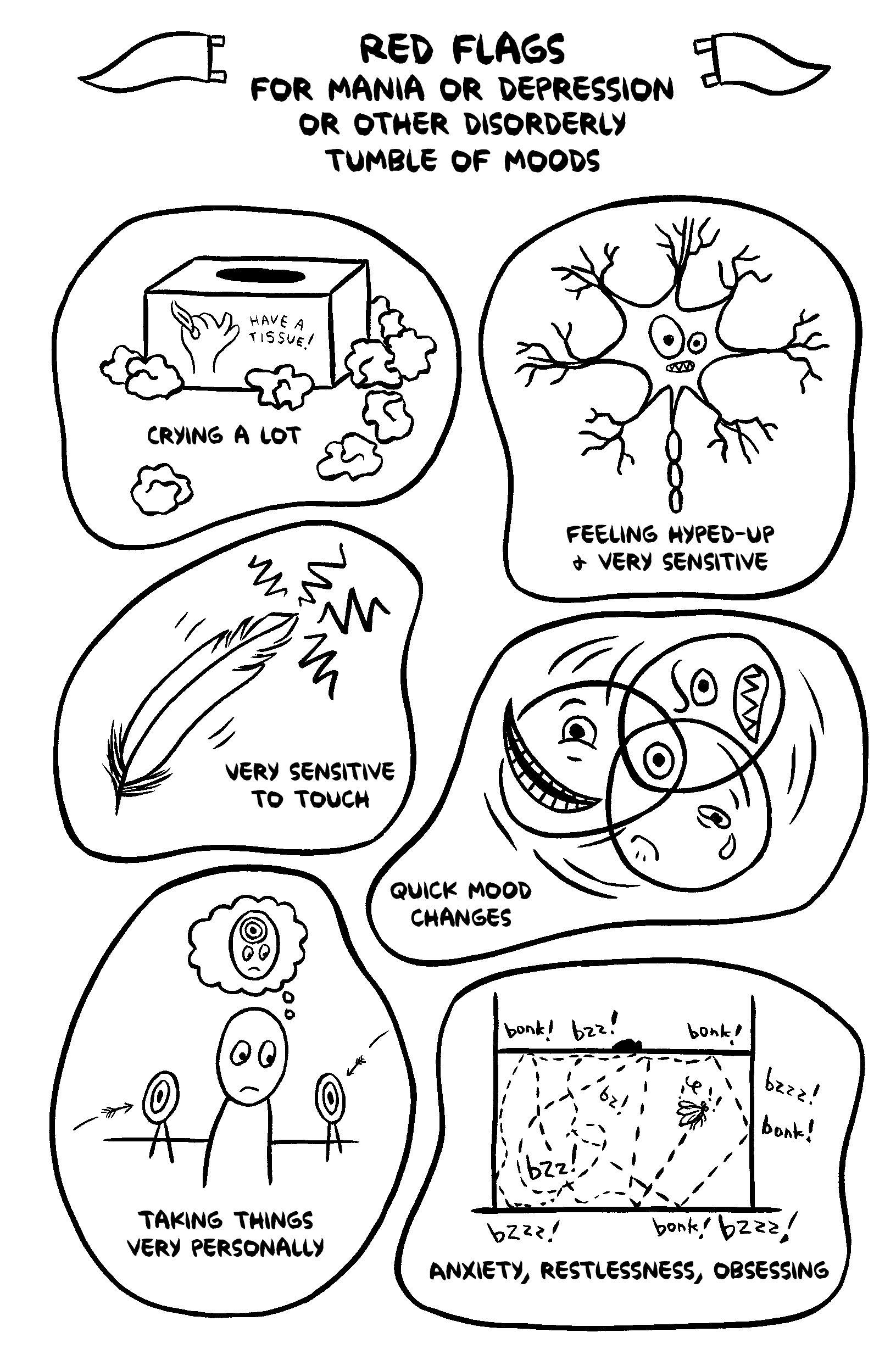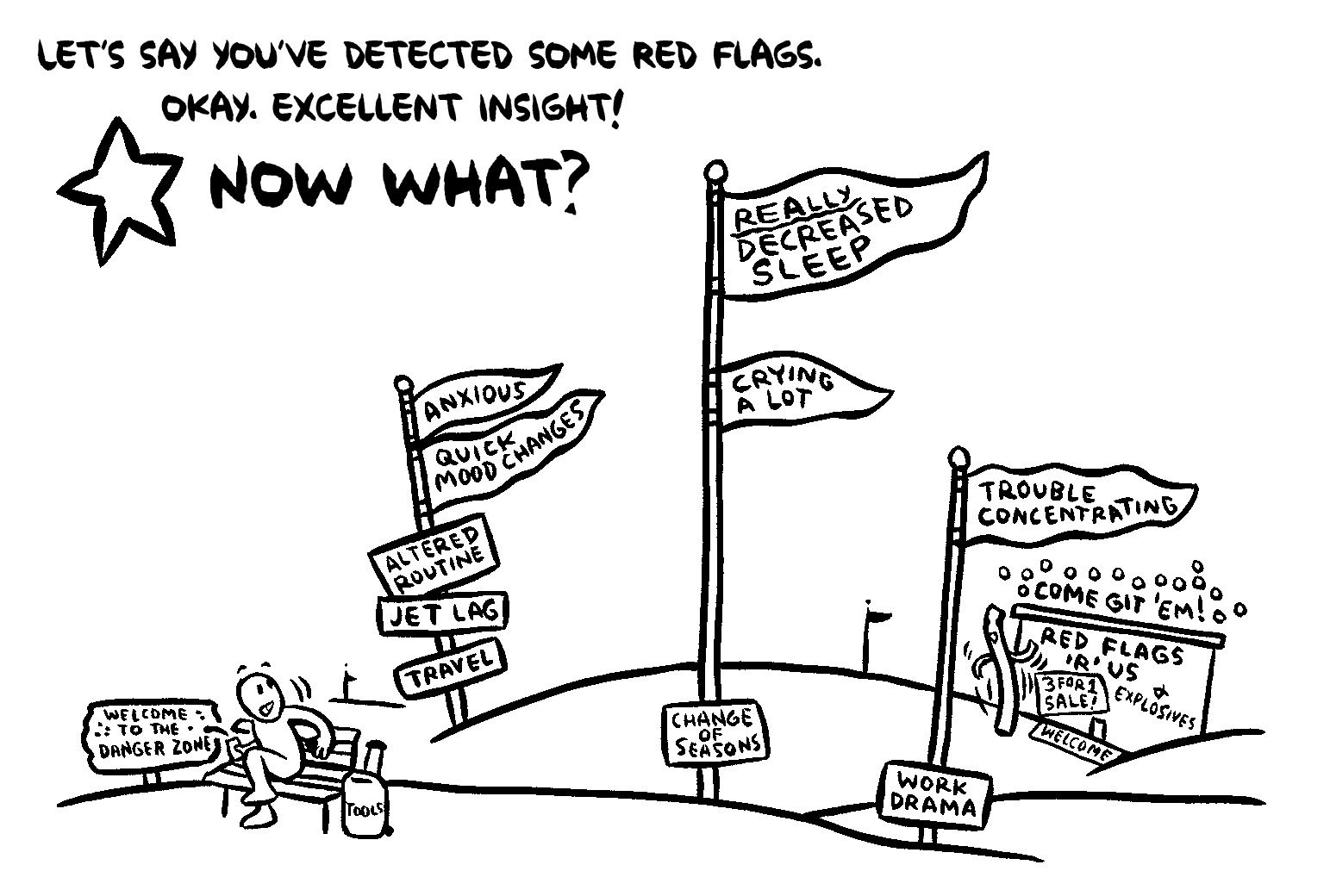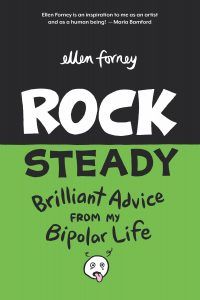
An Interview with Cartoonist Ellen Forney on “Rock Steady”
I was seven years into my bipolar disorder diagnosis when I first read Ellen Forney’s graphic memoir, Marbles: Mania, Depression, Michelangelo, and Me: A Graphic Memoir (2012). It was still—it is still—difficult to understand my illness and even harder to express the bipolar experience to others.
Forney’s memoir was a godsend. Bursting with visuals that translated the mental illness, Marbles helped the loved ones I pushed the book upon start to “get” my struggle in an accessible and compassionate way.
I was delighted to learn that Forney would be publishing a follow up, Rock Steady: Brilliant Advice from My Bipolar Life this year. Out now, Rock Steady is a compassionate, no-BS guide to living with this chronic illness from the perspective of someone who’s been there. Rock Steady bursts with practical coping skills and tools for enduring this lifelong battle.
I was so fortunate to be able to talk with Ellen Forney, one of my idols, about her new book, bipolar disorder, and the power of visual narratives.
The following conversation has been edited for length and clarity.
Forney on the inspiration behind Rock Steady
So why return to bipolar? Marbles is a comprehensive immersion into the experience of being diagnosed with a major mental illness and overcoming initial challenges to find a place of stability. I saw myself in Marbles, and people who I know who had experience with mental illness and read the graphic memoir agreed. Wouldn’t Marbles be the perfect mic drop on all things bipolar?
Ellen told me about the source of inspiration behind creating a manual like Rock Steady actually arose out of readers finding Marbles to be a guide of sorts: “One of the pieces of reader feedback that I got a fair bit was people telling me that they used Marbles like a manual, and I felt like, well, maybe we need a manual. Maybe I should do a manual, something that was more thorough.” What bipolar patients and their allies lacked was a guide from someone who’s lived with the illness themselves, and Forney could provide that perspective. Forney realized she still had much more to share: “I have way more breathing exercises, for example, that I think are useful, and I don’t get into mindfulness meditation at all [in Marbles] and all these other different aspects that I think are really important.” Rock Steady would pick up where Marbles left off with even more helpful advice and fill the gap in the literature.
Deciding what Rock Steady would include
To write Rock Steady, Forney wanted to look beyond her own personal experiences while still using them as a base: “I think my earliest idea of what this book was going to be was mostly the things that I found helpful, like the things that Ellen Forney found helpful, which would be kind of an extension of what was in Marbles.” In Marbles, Forney includes several examples of techniques that work for her, such as breathing exercises, and creates intricate drawings in the hopes that readers could benefit from them.
With Rock Steady, Forney included several topics, or “a combination of things,” she says, that “I found important in my own stabilizing and staying stable, things that I had feedback that I’ve gotten from readers” as well as questions from Marbles readers. A psych major in college who loves researching, Forney finds that “between Rock Steady and Marbles, it’s kind of the thesis that I never actually did in college.” Yet while Forney’s book is informed by her copious research, it never reads dry or stuffily academic.
At times, Rock Steady straddles all the different approaches to treating bipolar disorder. Having recently read a book that was aggressively anti-medicine for mental illness, I was impressed with how Forney manages to offer advice that could be helpful for everyone, no matter their treatment plan. Forney was well aware of being sensitive to tone and, as I suggested, not sounding judgmental about someone’s treatment choices:
“My philosophy is paying attention to a broad spectrum of things—where the SMEDMERTS comes in—because it’s so important to be aware of such a wide variety of different aspects of staying healthy. There’s a real emphasis on medications right now that I think is not helpful for a lot of people cause it means that there are a lot of different kinds of self care that are [also] really important that might not be emphasized, you know, like eating well or the importance of getting enough sleep.” Rock Steady would be inclusive for everyone, neither devaluing or praising one way to stay stable over another.

Excerpt from Ellen Forney’s “Rock Steady”: The SMEDMERTS Strategy
(Courtesy of Fantagraphics)
SMEDMERTS is made up of 9 key components to the Rock Steady Strategy for staying balanced and healthy: Sleep, Meds, Eat, Doctor, Mindfulness, Exercise, Routine, Tools, Support System. This one handy and memorable acronym is referenced throughout Rock Steady.
Using personal mistakes to help others
Alongside the latest research on bipolar and treatment, Forney included some of her own experience in a way that uses her mistakes as examples: “I include personal stories where I mess up.” One tricky area that many face is dating etiquette and disclosure, a topic Forney covers by using her experiences as a lesson on, “how it makes sense to very carefully tell someone that you’re dating that you have bipolar disorder, and make sure that you feel safe.” To show what not to do, Forney uses herself as a lesson.
Forney references a story that stuck out vividly in my mind from Rock Steady, the time she took Vitamin D instead of Lamictal for three days: “I think I knew that I was going through my system the best I could, but I messed up. And so, ok, I messed up. I recognize that I messed up. I called my doctor came up with a plan and got back on track and learned my lesson. And those are the kind of coping tools that will allow us to maintain stability for over the long term. It’s figuring out what to do when we mess up—not that we can never mess up—because that’s just not realistic.”

Author Ellen Forney
(Courtesy of Fantagraphics)
One of the messages Forney wants to convey with Rock Steady totally resonated with something I still struggle with: recognizing how hard life with bipolar can be, and treating yourself kindly even when you miss a dose or stay up too late. Forney wanted, “[to] emphasize that it’s hard, that it’s not the end of the world if you slip up, that it might be OK, or even if it’s not, you’ll figure it out.” This is definitely a message people with bipolar need to hear. Forney continued, “I will go ahead and say there is no optimal way that we can follow 24/7. It’s just not realistic.” In other words, don’t beat yourself up when you forget to pick up a med refill and miss a night’s dose.
This is especially valuable if you struggle with feeling like you must be a perfect, obedient bipolar patient like I do. The truth is, everyone screws up, and Forney strategically uses her own mistakes to help people feel like it’s okay to screw up sometimes. Rock Steady is more forgiving than your average bipolar self help guide. Given how a lifetime with bipolar can feel like a never-ending slog, readers with the illness will doubtless feel encouraged like I did to keep going even if you aren’t perfect. It’s a breath of fresh air to hear from someone who has been and is there when you get frustrated with all the maintenance you have to perform on a daily basis.
The advantage of a graphic narrative
I’d seen firsthand how many people in my intensive outpatient group therapy immediately identified with Marbles in particular because of its visual narrative as a graphic novel. Though I’ve read countless books on bipolar disorder, they don’t always have the same impact as Forney’s visuals, which capture the range of the bipolar experience in some ways better than mere words could do justice. Personally, I have a hard time focusing on reading when I’m manic, and engaging with the graphics in Marbles have helped me still feel plugged into reading and able to learn something vital, new, and helpful about my illness at a time I need it most.
Forney agreed with me about the power of comics, especially when someone with bipolar is faced with difficult symptoms like those in mania. “I know one of the things that has definitely come up a lot is how difficult it is to read, and particularly when you’re manic. I know it really was for me because I just didn’t like sitting and focusing on words, it took a little too much concentrated attention for the most part. And it’s one thing that I’ve heard from readers a lot is is that Marbles was the first book in a long time that they were able to read from cover to cover.” With comics, “there’s a lot of open space, and it just it comes from a lot of different directions so it engages your brain in a different kind of way. And in a very kind of thorough way, and it’s not just a whole bunch of little words.”

Excerpt from Ellen Forney’s “Rock Steady”: Identifying Red Flags
(Courtesy of Fantagraphics)
For Rock Steady, a visual guide to bipolar disorder, then, the advantage of the comics medium is clear. Forney agreed: “One of the things that I’m thinking Rock Steady will have in its favor, at least for those people who have a hard time focusing on words and text-based books when they’re manic, is that they’ll be able to focus on the different things in Rock Steady that they might not be able to focus on or remember in another format.”
Advice from your kindly bipolar cousin
When I was first diagnosed with bipolar disorder in 2006, there were only a few books available in the college bookstore to help me navigate my new life. One of the few books that spoke to me was Kay Redfield Jamison’s now-classic memoir of manic depression, An Unquiet Mind. Most of the rest of the books were written by doctors or mental health professionals who didn’t have the illness. Ever the contrarian, I remember myself having difficulty trusting the words of someone who didn’t really understand what was going on in my brain on a personal level. I loved Marbles because it balanced information and a unique perspective from someone who had the same condition that I did. It was that feeling of familiarity that I instantly connected to and brought me into the narrative.
Forney told me that people had described that voice as a big sister or “a cousin who you know who cares and who understands and has been through it and has sympathy,” someone who, “knows some of the pitfalls and also recognizes that you’re a different person from them.” In contrast to doctor-written narratives, “it’s such a different feel to hear from somebody who’s actually in it, too, like my saying, you know, that it’s hard to take your meds responsibly in every single way for years. I mean, coming from someone who has to take medication responsibly for years and years…It just has a different impact.” Forney’s personal voice brings authority but also makes Rock Steady approachable.

Excerpt from Ellen Forney’s “Rock Steady”: Noticing Red Flags
(Courtesy of Fantagraphics)
Rock Steady reads as if it’s written from someone who intimately knows your struggles and is there to help, but recognizes you are entitled to make your own treatment choices.
On the title Rock Steady
I’ve always been fascinated by the titles authors pick, and Forney’s explanation of her thoughtful choice for her Marbles follow up resonated with me. Bipolar disorder is an unending struggle between two extremes, which is one reason why I prefer the term manic depression. The push and pull between these poles requires a balancing act. Finding a middle ground of stability is crucial to not feeling like an unstable molecule bouncing around. The title Rock Steady pays homage to this dynamic while also offering some reassurance.
One of the great advantages that comics and graphic narratives can give people is a way to visualize an interior experience. Bipolar, like all mental illnesses, is rooted deep in the brain but manifests itself outwardly. At its essence, bipolar is brain chemicals in chaos. But while we can’t open a window and actually see dysfunctional neurotransmitters and sections of the brain lighting up the way they they shouldn’t, the experience is translated outward into visible symptoms. Seeing a drawing of a character curled up in fetal position on the couch is an instantly accessible way to describe depression. An image from Marbles that you hear described over and over is the character riding a carousel that goes up and down and up and down. Forney noted that “one of the visual metaphors in Marbles that has resonated I think for a lot of people is the carousel as a way to depict the different moods. And for me one of the most important visual metaphors in Rock Steady is really it’s related to the title. I don’t know how many people will get this pun, but they’re both verbs, and so what stability is about to me, is that it’s an action.” This is in contrast to how we normally think about stability. Forney continued, “I think the way that we generally interpret that is to have it as something that stays still. But what stability is really about with a mood disorder is that you’re going to rock, like life is going to rock either from within yourself because you have a mood disorder or just because that’s what life does.”

Excerpt from Ellen Forney’s “Rock Steady”: Finding Calm
(Courtesy of Fantagraphics)
The flip side is staying steady. “And steady as a verb, it means that it takes effort. And so it’s basically kind of going back between those things like rocking and steadying and rocking and steadying, and in the first chapter I draw someone standing in the middle of a seesaw. And to me that kind of that gets at what we need to do.” Getting balance when you’re in the middle is the real key to stability: “The idea is just is to stay. Figure out how to stay on the seesaw and not get thrown off. If you [do] get thrown off, figure out how to get yourself up, dust off your knees and get back on. You don’t lose if you fall off. You don’t lose, you just have to get back on.”
I’m grateful for Forney’s take on this, because to me it’s a gift. Living with bipolar makes it easy to feel like you’re constantly failing, you’re forever “losing” if you make a mistake. Rock Steady is an empowering guide from someone who’s been there and can give you no-BS but friendly advice on hacking this thing and carving out a life that’s manageable and balanced.
















